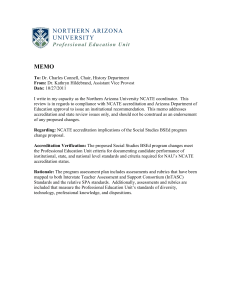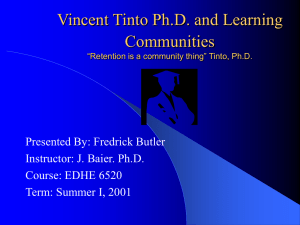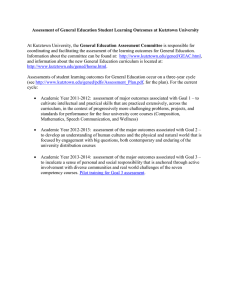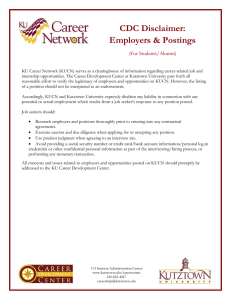All Things Assessment at KU
advertisement
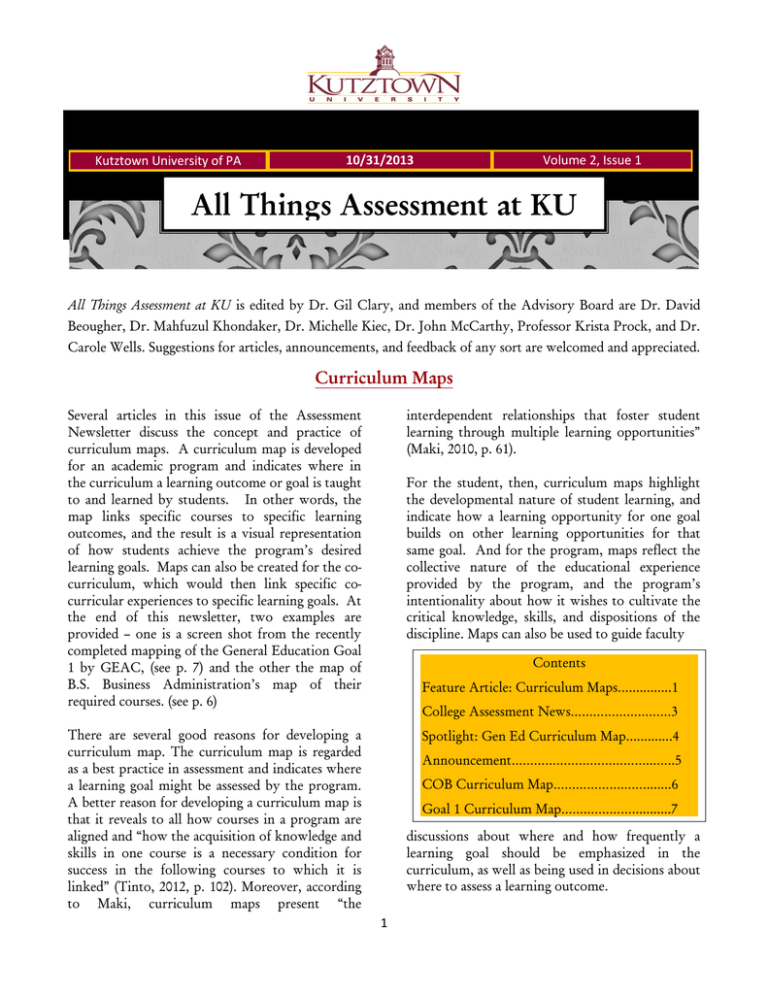
Kutztown University of PA 10/31/2013 Volume 2, Issue 1 All Things Assessment at KU All Things Assessment at KU is edited by Dr. Gil Clary, and members of the Advisory Board are Dr. David Beougher, Dr. Mahfuzul Khondaker, Dr. Michelle Kiec, Dr. John McCarthy, Professor Krista Prock, and Dr. Carole Wells. Suggestions for articles, announcements, and feedback of any sort are welcomed and appreciated. Curriculum Maps Several articles in this issue of the Assessment Newsletter discuss the concept and practice of curriculum maps. A curriculum map is developed for an academic program and indicates where in the curriculum a learning outcome or goal is taught to and learned by students. In other words, the map links specific courses to specific learning outcomes, and the result is a visual representation of how students achieve the program’s desired learning goals. Maps can also be created for the cocurriculum, which would then link specific cocurricular experiences to specific learning goals. At the end of this newsletter, two examples are provided – one is a screen shot from the recently completed mapping of the General Education Goal 1 by GEAC, (see p. 7) and the other the map of B.S. Business Administration’s map of their required courses. (see p. 6) interdependent relationships that foster student learning through multiple learning opportunities” (Maki, 2010, p. 61). There are several good reasons for developing a curriculum map. The curriculum map is regarded as a best practice in assessment and indicates where a learning goal might be assessed by the program. A better reason for developing a curriculum map is that it reveals to all how courses in a program are aligned and “how the acquisition of knowledge and skills in one course is a necessary condition for success in the following courses to which it is linked” (Tinto, 2012, p. 102). Moreover, according to Maki, curriculum maps present “the Spotlight: Gen Ed Curriculum Map.............4 For the student, then, curriculum maps highlight the developmental nature of student learning, and indicate how a learning opportunity for one goal builds on other learning opportunities for that same goal. And for the program, maps reflect the collective nature of the educational experience provided by the program, and the program’s intentionality about how it wishes to cultivate the critical knowledge, skills, and dispositions of the discipline. Maps can also be used to guide faculty Contents Feature Article: Curriculum Maps…............1 College Assessment News………………………3 Announcement………………………………...…..5 COB Curriculum Map……………………........6 Goal 1 Curriculum Map…….…………...........7 discussions about where and how frequently a learning goal should be emphasized in the curriculum, as well as being used in decisions about where to assess a learning outcome. 1 rarely aligned, either in content or in pedagogy, in ways that promote the successful completion of sequential courses in the first year and beyond. This lack of integration occurs not only within programs of study but within developmental course sequences as well. It is still too often the case that students will successfully complete their developmental course sequence only to struggle and fail in the course to which the successful completion of that developmental sequence is a requirement. (Tinto, 2012, pp. 102103) With respect to actually developing a curriculum map, one starts with a grid sheet with the courses of a program listed down the left side and the student learning outcomes across the top. In the simplest case, the map will indicate for each course which learning outcomes are being taught and learned. The recent mapping by the General Education Assessment Committee illustrates the process, as can be seen in the screen shot of an Excel file on page 7. A more sophisticated map links the course to its placement in the development of the learning outcome – that is, whether the course Introduces the outcome, further Develops the outcome, or provides opportunities for additional Practice of the learning goal. The curriculum map for the BSBA program illustrates this approach; this example is found on page 6 and comes from the map produced by our assessment management software TracDat (here, learning outcomes appear on the left side and courses on the top of the page). In terms of connecting courses to outcomes, the ideal situation is that faculty members in a program come to agreement about the linkages between courses and outcomes, and especially the sequence in which learning opportunities are presented to students as they develop the knowledge, skill, or disposition. There are, then, a number of aspects of curriculum maps and the mapping process that recommend its use. Curriculum maps provide students with a pathway through the curriculum and clearly identify the student learning outcomes that are the central point of the educational experience. Moreover, mapping the curriculum encourages a program’s faculty to collectively think through and create the pathway, and Tinto (2012) discusses research showing that students who follow a more orderly sequence of courses tend to have a higher graduation rate. Finally, curriculum maps and mapping contribute to an institution’s effectiveness: Jenkins (2006), as quoted in Tinto (2012), observes that “the key to a college’s effectiveness is not whether it adopts particular policies or practices, but how well it aligns and manages all of its programs and services to support student success.” (p. 104) One objection to developing a curriculum map is that it is redundant with existing practices. It is useful, I think, to let Tinto speak to this objection: The common specification of course prerequisites and the listing of course numbers suggest a logical sequence of course taking. Yet programs of study rarely make explicit the way courses within a program are related to each other, empirically document the degree to which they are associated with success in those courses, or restructure those courses to better promote student progress through the program. The courses are References Maki, P. L. (2010). Assessing for learning: Building a sustainable commitment across the institution (2nd ed). Sterling VA: Stylus. Tinto, V. (2012). Completing college: Rethinking institutional action. Chicago: University of Chicago. 2 College Assessment Committee News improvement on six national standards, which include: College of Business Early in its journey to AACSB accreditation, the Department of Business Administration at Kutztown University developed its first curriculum maps for the B.S. in Business Administration and Masters in Business Administration programs. A first use of the maps was to identify learning goals that were not receiving sufficient attention in the curriculum. These conversations were followed by later discussions about assessment results, which led to a series of revisions to the curriculum map, with the map reflecting where and to what degree an individual course is directed toward a specific learning outcome. Candidate Knowledge, Skills, and Professional Dispositions; Assessment and Unit Evaluation; Field Experience and Clinical Practice; Diversity; Faculty Qualifications, Performance, and Development; Unit Governance and Resources. The Board of Examiner Team found that COE teacher candidates exemplify appropriate knowledge, skills, and dispositions, as the Unit aligns internal assessments with state and national standards and provides for fairness, consistency, and reliability in its data collection efforts. Further, the Team confirmed and highlighted that teacher candidates’ clinical experiences enable them to integrate general, professional, and pedagogical knowledge and skills in diverse settings in order to create meaningful learning experiences for all students. In these College of Business programs, the maps are one link in the larger chain of teaching, learning, assessment, and improvement. The chain begins with the program’s mission statement, which then serves as the basis for the learning goals. The mapping process begins with linking each learning goal to specific courses in the curriculum, a process that is determined by Business Administration faculty. These linkages are then used to inform each course’s master syllabus, with the goal of ensuring that the learning objectives of the course are aligned with the curriculum map and at the appropriate level in Bloom’s taxonomy. The master syllabus then guides the development of an individual instructor’s syllabus, which in turn informs the instructor’s coverage of the learning goal in the course. Overall, the curriculum maps clearly demonstrate the strategies being used by the Business Administration programs to help their students achieve the essential learning goals. On Monday, October 28, 2013, NCATE (now called the Council for the Accreditation of Educator Preparation or CAEP) gave official notification to the COE of its Continuing Accreditation, for an additional 7 years. College of Liberal Arts & Sciences Continuing its focus on assessing student retention, persistence, and graduation, the College of Liberal Arts and Sciences used information provided by the LAS assessment committee to hone in on advisement. Evidence collected in varied venues led to the creation of an advisement taskforce that determined how to support and facilitate one on one advising sessions between faculty and students. The taskforce noted the time consumed in accessing the multitude of policies, forms, and materials necessary for informed, quality advising. They determined that time spent searching for information was a distraction. Their request resulted in a D2L page for CLAS advisors that consolidated links and guidelines on one page. College of Education In April 2013, the College of Education (COE) hosted its re-accreditation site visit conducted by a 5-member Board of Examiner team from the National Council on Accreditation of Teacher Education (NCATE). NCATE Accreditation is based upon compliance with and continuous 3 Education curriculum and contributes to the Oral Communication learning outcome. This work contributed to the University’s assessment of our General Education program’s Goal 1 – to cultivate intellectual and practical skills that are practiced extensively, across the curriculum, in the context of progressively more challenging problems, projects, and standards for performance. The article is titled “Slaying the assessment dragon: One department’s efforts to tame the beast and survive as the knights in shining armor” and appeared in the peer reviewed, online Journal of the Association of Communication Administration (volume 32: 1, pp. 29 – 41). It can be found at http://www.unco.edu/aca/Journal.html. With the D2L page, advisors click on a link and a new window opens with the form, the policy, or the check sheet. This enables more time to be spent advising and less time on looking for information related to that particular student’s needs. All faculty advisors in the college have access to the new site and will be able to use it for advising this semester. College of Visual & Performing Arts Mary Eicholtz (Department of Communication Studies) and Jay Baglia (a former member of the department, now at DePaul University) recently published a case study on their experience in coordinating the department’s assessment of the Fundamentals of Oral Communication course (COM 010). The course is part of the General Assessment Spotlight: General Education Curriculum Map exposed to the skills, content, and responsibilities associated with each of the goals of general education. It is a matrix that provides a snapshot of the connection between the curriculum and its expected outcomes. Its structure consists of an outline of the three general education goals and their associated objectives, or learning domains along with curricular offerings. At KU, the curriculum map will reflect all active university courses, since all courses may be used by students to meet general education requirements. In fall 2010 Kutztown University implemented an updated general education curriculum, developed by the General Education Task Force and approved by the University Senate, APSCUF Representative Council, and UCC (www.kutztown.edu/gened). To ensure the curriculum’s viability, the task force created the General Education Assessment Committee (GEAC) and charged it with implementing and monitoring a cycle of assessment and continuous improvement. In this assessment, a curriculum map is indispensable. The curriculum map shows strengths and opportunities of curricular offerings. Since the matrix reflects the relationship between the curriculum and its expected outcomes, it has the potential to reveal gaps in the curriculum. That is, with the map one can ask if there are learning goals that are not being covered in the curriculum or are receiving relatively light coverage. The curriculum map can also be used to identify courses to be used to assess a particular goal and domain of the KU General Education program. Assessment consists of a systematic and rigorous method for the collection, analysis, and use of data related to direct evidence of student learning outcomes for the purpose of measuring and ultimately improving the effectiveness of the general education program. Assessments, in other words, assist us in answering questions about whether our students are learning the knowledge, skills, and dispositions we want all KU students to possess, and these answers in turn help fuel continuous improvement. To develop the first draft of the KU Curriculum Map, each department was asked to consider every one of its active courses and use the course description and/or the course objectives to identify One important tool in the assessment process is the curriculum map. The curriculum map is a graphic presentation that displays where students are 4 Map will be a part of the General Education’s ongoing assessment and renewal process. As such, it is a living document and will require periodic maintenance. at least one of the domains listed under the three general education goals that the course addresses. In the first draft of the curriculum map completed in Spring 2013, at least 1 and perhaps no more than 2 domains most relevant to each course were selected. (Refer again to the screenshot of a small portion of the General Education curriculum map at the end of this newsletter.) The Curriculum Announcement Dr. Lynn Kutch’s (Modern Language Studies) recent teaching – learning – assessment project in a German language course is featured on a webpage of the Association of American Colleges and Universities (AAC&U). The work is part of AAC&U’s LEAP Campus Toolkit: Resources and Models (http://leap.aacu.org/toolkit/projects/value-project); the direct link to Dr. Kutch’s work is http://leap.aacu.org/toolkit/learning-outcomes-assessment/2013/value-reading-rubric-sample. 5 Program - Business Administration (BS) - Curriculum Map Legend: (1) Introduced, (2) Practiced, (3) Developed Learning Outcomes ACC 121 ACC 122 BUS 131 BUS 171 BUS 320 ECO 11 ECO 12 ECO 360 FIN 350 FIN 365 Communicatio n skills: Oral 2 Communicatio n Skills: Written . 1, 2 . . . . . . . . Teamwork 1, 2 1, 2 1, 2 1, 2 1, 2 Fundamental Business Concepts 1, 2 1, 2 1, 2 1, 2 1, 2 Ethics (5.a) 1 1 1, 2 1 . Impact of Global environment (5.b) Current Business Issues (5.d) 1 1 . 1 . 1 . . 1 . . . 1 . 1, 2 . . 1 . 1, 2 1, 2 . . 1 . 1 . 1 6 . . . . 1, 2 . 1, 2 1, 2 1, 2 . . . 1, 2 1 1, 2 3 . . . . 3 1 1, 2 MKT 370 3 1, 2 Analysis and Critical Thinking Diversity (5.c) MGM MGM MGM MGM MKT 210 351 352 399 210 . 1, 2 . 2, 3 3 1 3 1 2, 3 1 3 1, 2 3 1 . 1, 2 . Portion of the General Education Curriculum Map 7
